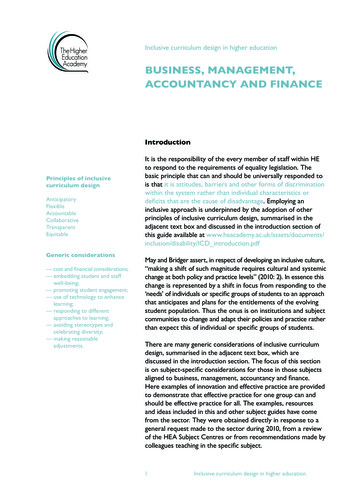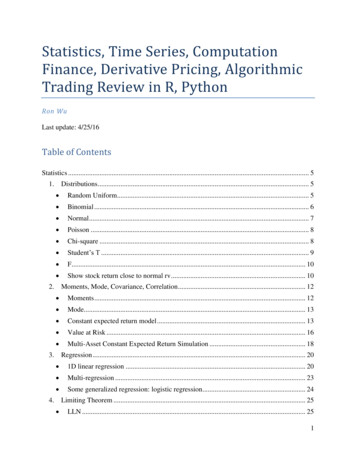
Transcription
CHAPTER 1INTRODUCTON TOHEALTHCARE FINANCET heme S et - U p :CareersinH e a lt hc a r e M a n a g e m e n tIf you are using this book, you either are working in healthcare or are interested in a career in healthcare.Of course, numerous career opportunities are available in clinical fields, including medicine, dentistry,nursing, and occupational and physical therapy, which some of you are already practicing or will enteron graduation. However, most of you are considering careers in healthcare management. In addition,many clinicians find themselves balancing both clinical and administrative roles, and so healthcaremanagement knowledge is important.According to the Association of University Programs in Health Administration, an education inhealthcare management will prepare you to enter the exciting and challenging healthcare field, thelargest in the United States, representing more than 11 million jobs. Healthcare executives have theopportunity to make a significant contribution to improving the health of the population and to workin one of tens of thousands of healthcare organizations throughout the United States and the world.An education in healthcare management can take you in many different directions. Career options for healthcare managers have never been more diverse or exciting. The kind of entry-level jobsoffered to a college graduate varies in terms of the individual’s interests, skills, and experience. Today,3This is an unedited proof.Copying and distribution of this PDF is prohibited without written permission.For permission, please contact Copyright Clearance Center at www.copyright.com
4Fundamentals 0f Healthcare Financean estimated 300,000 people serve in healthcare management positions (from entry levelto middle management to leadership) and in organizations of all sizes (from a practice withseveral people to a major corporation that employs thousands). After gaining the requisiteexperience, many healthcare management graduates are in a position to shape the futureof healthcare in the United States and across the globe.All that probably sounds good, but what types of organizations might be interestedin hiring a healthcare management graduate? By the end of the chapter, you will have anidea of the settings available. See if any of them appeal to you.L earning O b j ecti v esAfter studying this chapter, you will be able to do the following: Define the term healthcare finance as it is used in this book. Discuss the structure of the finance department, the role of finance in healthcareorganizations, and how this role has changed over time. Describe the major players in the healthcare sector. List the key issues currently facing healthcare managers.This is an unedited proof.Copying and distribution of this PDF is prohibited without written permission.For permission, please contact Copyright Clearance Center at www.copyright.com
C h a p t e r 1 : I n t r o d u c t o n To H e a l t h c a r e F i n a n c e1.1 INTRODUCTIONIn today’s healthcare environment, where financial realities play an important role in many,if not most, decisions, healthcare managers at all levels must understand the fundamentals offinance and how that knowledge is used to enhance the financial well-being of the institution.In this chapter, we introduce you to the rationale that underlies this book. Furthermore,we present background information about healthcare finance and the different types ofhealthcare organizations. We sincerely hope that this book provides significant help in yourquest to increase your professional competency in the critical area of healthcare finance.5Healthcare financingThe system that asociety uses to pay forhealthcare services.Health servicesorganizationsOrganizations thatprovide patient careservices. Examples1.2 DEFINING HEALTHCARE FINANCEinclude hospitals,medical practices,clinics, and nursingWhat is healthcare finance? It can be surprising to find that there is no single responsehomes. Also calledbecause the definition of the term depends, for the most part, on the context in which itproviders.is used. Thus, your understanding should begin with learning the scope and meaning ofthe term healthcare finance as it is used in this book.AccountingTo start, recognize that healthcare finance is not about financing the healthcareThe measurementsystem. Healthcare financing is a separate topic that involves how society pays for theand recording ofhealthcare services it consumes. This issue is a complex and politically charged, and we doevents that reflect thenot tackle it directly in this book. Of course, the manner of financing healthcare affectsoperations, assets,how hospitals and physicians are reimbursed for services and hence has a significant influand financing of anence on healthcare finance.organization.Most users of this book will become (oralready are) managers at healthcare organizations,CRITICAL CONCEPTsuch as medical group practices, hospitals, homeHealthcare Financehealth agencies, or long-term care facilities. Thus,to create a book that provides the most value to itsHealthcare finance can have many different definitions, deprimary users, we focused on finance as it appliespending on the setting. For our purposes, healthcare financein health services organizations. Of course, theencompasses the accounting and financial management funcprinciples and practices of finance cannot be studtions of healthcare organizations. Accounting involves theied in a vacuum but must be based on the realitiesmeasurement, in financial terms, of a business’s operationsof the current healthcare environment, includingand financial status, while financial management (corporatehow healthcare services are financed.finance) involves the application of theory and concepts deIn health services organizations, healthcareveloped to help managers make better decisions. In practice,finance consists of both the accounting and finanthe two functions blend, with accounting generating the datacial management functions (see “Critical Conneeded to make sound decisions and financial managementcept: Healthcare Finance”). Accounting, as itsproviding the framework for those decisions.name implies, concerns the recording, in financialterms, of economic events that reflect the operations, assets, and financing of an organization.This is an unedited proof.Copying and distribution of this PDF is prohibited without written permission.For permission, please contact Copyright Clearance Center at www.copyright.com
6Financial managementThe use of theory,principles, andconcepts developedto help managersmake better financialdecisions.Fundamentals 0f Healthcare FinanceIn general, the purpose of accounting is to create and provide to interested parties—bothinternal (managers) and external (investors)—useful information about an organization’sfinancial status and operations.Whereas accounting provides a rational means by which to measure a business’sfinancial performance and to assess operations, financial management (often called corporate finance) provides the theory, concepts, and tools necessary to help managers makebetter financial decisions. Of course, the boundary between accounting and financialmanagement is blurred; certain aspects of accounting involve decision-making, and muchof the application of financial management concepts requires accounting data.S elf - T est Q uestions1. What does the term healthcare finance mean?2. What is the difference between accounting and financialmanagement?Chief financial officer(CFO)The senior manager(or top finance dog) ina large organization’sfinance department.Also called vicepresident—finance.1.3 T HE ROLE OF FINANCE IN HEALTH SERVICESORGANIZATIONSThe primary role of finance in health services organizations, as in all businesses, is to planfor, acquire, and use resources to maximize the efficiency (and value) of the enterprise (see“Critical Concept: Role of Finance”). As discussed in section 1.4 of this chapter, the twobroad areas of finance—accounting and financial management—are separate functionsat larger organizations, although the accounting function usually is carried out under thedirection of the organization’s chief financial officer (CFO) and hence falls under theoverall category of finance.F inance A cti v itiesCRITICAL CONCEPTRole of FinanceThe primary role of finance in health services organizations is toplan for, acquire, and use resources to maximize the efficiencyof the organization. This role is implemented through specificactivities such as planning and budgeting.Chapters 1 through 3 of this book provide foundational information that is helpful for understanding finance activities. The specific finance activitiesexplored in the remaining chapters of this bookinclude the following: Estimating costs and profitability, planning,and budgeting. First and foremost,healthcare finance involves evaluating theThis is an unedited proof.Copying and distribution of this PDF is prohibited without written permission.For permission, please contact Copyright Clearance Center at www.copyright.com
C h a p t e r 1 : I n t r o d u c t o n To H e a l t h c a r e F i n a n c efinancial effectiveness of current operations and planning for the future.Chapters 4 through 6 cover these functions. Managing financial operations. Healthcare organizations spend a lot of timemanaging cash and supply inventories as well as collecting money owed forservices rendered. Proper management of these functions is necessary toensure operational effectiveness and to reduce costs. Typically, managers at alllevels are involved, to a greater or lesser extent, in these processes, which arediscussed in chapter 7. Financing decisions. All organizations must raise funds to buy the assetsnecessary to support operations. Such decisions involve many issues, such asthe choice between long-term and short-term debt and the use of leases versusconventional financing. Senior managers and the financial staff typically makethe financing decisions, but these decisions have ramifications for managers atall levels. Business financing is the subject of chapter 8. Capital investment decisions. One of the most critical decisions managers makeis the selection of new facilities (including land, buildings, and equipment).Such decisions are the primary means by which businesses implement strategicplans; hence, they play a key role in a business’s financial future. Chapters 9and 10 describe these decisions, which affect everyone in the organization. Financial reporting. For a variety of reasons, businesses must record and reportto outsiders the results of operations and current financial status. This task istypically accomplished with a set of financial statements, which are explainedin chapters 11 and 12. Financial and operational analysis. To achieve and maintain a high levelof organizational performance, businesses must constantly monitor bothfinancial and operational conditions and take actions as needed to ensure thatgoals are met. Chapters 7 and 13 address these topics.In addition to those finance activities that involve operational managers, the following activities are accomplished primarily by the finance staff: Contract management. In today’s healthcare environment, health servicesorganizations must negotiate, sign, and monitor contracts with managedcare organizations and health insurers. The finance staff typically has primaryresponsibility for these tasks, though operational managers clearly areaffected by external contracts and must be involved in their negotiation andmanagement.This is an unedited proof.Copying and distribution of this PDF is prohibited without written permission.For permission, please contact Copyright Clearance Center at www.copyright.com7
8Fundamentals 0f Healthcare Finance Financial risk management. Many financial transactions that take place tosupport the operations of a business can, in themselves, increase a business’srisk. Thus, an important finance staff activity is to manage financial risk.T he F our C sThe finance activities at health services organizations may be summarized by the four Cs:costs, cash, capital, and control (see “Critical Concept: The Four Cs”).The measurement and minimization ofcostsarevital activities to the financial success of allCRITICAL CONCEPThealthcare organizations. Rampant costs, comparedThe Four Csto revenues, usually spell doom for any business.A business might be profitable but still faceThe finance activities in healthcare organizations can be suma crisis because of a shortage of cash. Cash is themarized by the four Cs: (1) cost measurement and minimization,lubricant that makes the wheels of a business run(2) cash management, (3) capital acquisition, and (4) controlsmoothly; without it, the business grinds to a halt.of resources.In essence, businesses must have sufficient cash onhand (or the ability to raise it quickly) to meet cashobligations as they occur. In healthcare, a criticalpart of managing cash is collecting money frominsurers for patient services provided. (This element is so important that some healthcarefinance professors include collections as the fifth C.)Capital represents the funds (money) used to acquire land, buildings, and equipment.Without capital, healthcare businesses would not have the physical resources needed toprovide patient services. Thus, capital allows healthcare organizations to meet the healthcareneeds of their communities.Finally, a business must control its financial and physical resources to ensure that theyare being wisely employed and protected for future use. In addition to meeting current missionrequirements, healthcare organizations must plan to meet society’s future healthcare needs.I mportanceofF inanceo v erT imeIn times of high profitability and abundant financial resources, the finance function tendsto decline in significance. For example, when most health services organizations werereimbursed on the basis of the actual costs they incurred, the role of finance was minimal.At that time, the most critical finance function was cost accounting because it was moreimportant to account for costs than it was to control them. In response to payer (primarilyMedicare) requirements, health services organizations (primarily hospitals) churned out amultitude of reports to comply with regulations and to maximize revenues. The complexitiesof cost reimbursement meant that a large amount of time had to be spent on cumbersomeThis is an unedited proof.Copying and distribution of this PDF is prohibited without written permission.For permission, please contact Copyright Clearance Center at www.copyright.com
C h a p t e r 1 : I n t r o d u c t o n To H e a l t h c a r e F i n a n c eaccounting, billing, and collection procedures. Thus, instead of focusing on value-addingactivities, most finance work focused on bureaucratic functions.In recent years, however, providers have redesigned their finance functions to recognize the changes that have occurred in the health services field. Billing and collectionsremain important, but to be of maximum value to the enterprise, the finance function mustsupport cost-containment efforts, managed care and other payer contract negotiations, jointventure decisions, and integrated delivery system participation. In essence, finance must helplead organizations into the future rather than merely record what has happened in the past.Although in this book our emphasis is on finance, we must stress that all organizationalfunctions are important. In addition to finance, managers must understand some elementsof many different functions, such as marketing, facilities management, and human resourcemanagement. All business decisions have financial implications, however, so all managers(whether in operations, marketing, personnel, or facilities) must know enough about financeto incorporate financial considerations properly into the plans and decisions in their specialized areas (see “For Your Consideration: Do Nonfinancial Managers Need to Know Finance?”).S elf - T est Q uestions1. What is the role of finance in today’s healthcare organizations?2. What are the four Cs?3. How has the role of finance changed over time?FOR YOUR CONSIDERATIONDo Nonfinancial Managers Need to Know Finance?A much-debated topic at the water cooler is whether nonfinancial managers, includingclinical managers, need to know much about finance. As outlined in the American College of Healthcare Executives (ACHE) 2017 Competencies Assessment Tool, healthcaremanagers should over time attain competencies in 21 areas of financial management.Among the areas listed are basic accounting principles, reimbursement principles, budgeting, revenue generation, performance monitoring, and applying financial planning toorganizational objectives. Of course, financial management competencies represent onlya small proportion of the complete list of management competencies assessed by thetool. Still, by including financial management in the assessment tool, ACHE considers ita key skill set for healthcare managers regardless of work setting or years of experience.What do you think? Do nonfinancial general managers need financial managementskills? What about clinical managers? Justify your answers.This is an unedited proof.Copying and distribution of this PDF is prohibited without written permission.For permission, please contact Copyright Clearance Center at www.copyright.com9
10Fundamentals 0f Healthcare Finance1.4 THE STRUCTURE OF THE FINANCE DEPARTMENTComptrollerThe financedepartment managerwho handlesaccounting, budgeting,and reportingactivities.TreasurerThe financedepartment managerwho handles capitalacquisition, investmentmanagement, and riskmanagement activities.Business (practice)managerThe managerresponsible for thefinance function ina small healthcareorganization, such asa medical practice withone or a few clinicians.The structure of the finance department depends on the type (e.g., hospital, medical practice) and size of the healthcare organization. Large organizations generally structure theirfinance departments in the following way.The head of the finance department holds the title of chief financial officer (CFO).(The title of vice president—finance is also used.) This individual typically reports directlyto the organization’s chief executive officer (CEO) and is responsible for all finance activities in the organization. The CFO directs two senior managers who help manage financeactivities: the comptroller and the treasurer.The comptroller (pronounced, and sometimes spelled, “controller”) is responsiblefor accounting and reporting activities, such as routine budgeting, preparation of financial statements, and patient accounts management. For the most part, the comptroller isinvolved in activities covered in chapters 4 through 7, 11, and 12of this text. The treasureris responsible for the acquisition and management of capital (funds). In other words, thetreasurer must raise the funds needed by the organization and ensure that those funds areeffectively used. Specific activities include the acquisition of capital, cash and debt management, lease financing, financial risk management, and endowment fund management (innot-for-profits). In general, the treasurer is involved in those activities discussed in chapters8 through 10 and chapter 13 of this book.In large organizations, the comptroller and treasurer have managers under themwho are responsible for specific functions, such as the patient accounts manager, who reportsto the comptroller, and the cash manager, who reports to the treasurer. In small businesses,many of the finance responsibilities are combined and assigned to one individual. Forexample, in a small group practice, the finance function is managed by one person, oftencalled the business (practice) manager, who typically is supported by one or more clerks.S elf - T est Q uestions1. Briefly describe the typical structure of the finance department in alarge healthcare organization.2. How does the size of the organization affect the finance departmentstructure?1.5 HEALTHCARE SETTINGSHealthcare services are provided in numerous settings, including hospitals, ambulatorycare offices and clinics, long-term care facilities, and integrated delivery systems. Beforethe 1980s, most healthcare organizations were freestanding and not formally linked withThis is an unedited proof.Copying and distribution of this PDF is prohibited without written permission.For permission, please contact Copyright Clearance Center at www.copyright.com
C h a p t e r 1 : I n t r o d u c t o n To H e a l t h c a r e F i n a n c eother organizations. Those that were linked tended to be part of horizontal systems, whichcontrol a single type of healthcare facility, such as a group of hospitals or nursing homes.Recently, however, many healthcare organizations have created vertical systems, whichcontrol different types of providers such as medical practices, hospitals, and nursing homes.11Horizontal systemA single business entitythat owns a group ofsimilar providers, suchas hospitals.H ospitalsHospitals provide diagnostic and therapeutic services to individuals who require more thanseveral hours of care, although most hospitals are actively engaged in ambulatory (walkin) services as well. To ensure a minimum standard of safety and quality, hospitals mustbe licensed by the state and undergo inspections for compliance with state regulations.In addition, most hospitals are accredited by The Joint Commission (previously calledthe Joint Commission on Accreditation of Healthcare Organizations). Joint Commissionaccreditation is a voluntary process intended to promote high standards of care. Althoughthe cost to achieve and maintain compliance with standards can be substantial, accreditationprovides eligibility for participation in the Medicare and Medicaid programs, and hencemost hospitals seek accreditation (chapter 3 discusses Medicare and Medicaid).Recent environmental and operational changes have created significant challenges forhospital managers. For example, many hospitals are experiencing decreasing admission ratesand shorter lengths of stay, resulting in reduced revenues and excess capacity. On the otherhand, hospitals in fast-growing areas are hard-pressed to keep ahead of patient demand. Inaddition, all hospitals are being pressured to reduce costs by reimbursement rates that failto keep up with inflation and to assume greater risk in their contracts with payers.Hospitals differ in function, length of patient stay, size, and ownership. These factors affect the type and quantity of assets, services offered, and management requirementsand often determine the type and level of reimbursement. Hospitals are classified as eithergeneral acute care facilities or specialty facilities.General acute care hospitals provide general medical and surgical services andselected acute specialty services. Such hospitals, which account for the majority of hospitals,have relatively short lengths of stay, typically a week or less. Specialty hospitals, such aspsychiatric, children’s, women’s, rehabilitation, and cancer facilities, limit the admission ofpatients to specific ages, sexes, illnesses, or conditions. The number of specialty hospitalshas grown significantly in the past few decades because of the belief that such hospitalscan provide better patient services than can hospitals that treat all conditions. In addition,specialty hospitals often experience lower costs than general hospitals because they do notrequire the overhead associated with providing many different types of services.Hospitals vary in size from fewer than 25 beds to more than 1,000 beds; generalacute care hospitals tend to be larger than specialty hospitals. Although economists donot all agree, the general belief is that the optimal hospital size is about 400–500 beds.Smaller hospitals do not benefit from economies of scale, while larger hospitals are tooThis is an unedited proof.Copying and distribution of this PDF is prohibited without written permission.For permission, please contact Copyright Clearance Center at www.copyright.comVertical systemA single businessentity that owns agroup of related, butnot identical, providers,such as hospitals,medical practices, andnursing homes.The Joint CommissionThe accreditationbody for hospitals andother health servicesorganizations.General acute carehospitalA hospital that treatsall conditions thatrequire a relativelyshort hospitalization(e.g., fewer than 30days).Specialty hospitalA hospital that treatspatients with acommon characteristicor condition, such as achildren’s or a cancerhospital.
12Government hospitalA hospital owned bya government entity.Federal hospitals areowned by the federalgovernment, whilepublic hospitals areowned (or funded)by state or localgovernments.Private not-for-profithospitalA hospital that is notgovernmental butis operated for theexclusive benefit of thecommunity.Investor-ownedhospitalA hospital that isowned by investorswho benefit financiallyfrom its operation.Also called a for-profithospital.Fundamentals 0f Healthcare Financebig to manage efficiently (have diseconomies of scale). Small hospitals, those with fewerthan 100 beds, tend to be located in rural areas. Many rural hospitals have experiencedfinancial difficulties in recent years because they have less flexibility than large hospitals,limiting their ability to lower costs in response to tightening reimbursement rates. Mostof the largest hospitals are academic health centers or teaching hospitals. These hospitalsoffer a wide range of services, including tertiary care, which consists of specialized servicesfor patients with unusually severe, complex, or uncommon problems.Hospitals are classified by ownership as governmental, private not-for-profit, or investor owned. Government hospitals, which make up about 22 percent of all hospitals, arebroken down into federal and public (nonfederal) entities. Federal hospitals, such as thoseoperated by the uniformed services or the US Department of Veterans Affairs, serve specialpurposes. Public hospitals are funded wholly or in part by a city, county, tax district, or state.In general, federal and public hospitals provide substantial services to indigent patients. Inrecent years, many public hospitals have converted to other ownership categories (primarily, private not-for-profit) because local governments have found it increasingly difficultto fund healthcare services and at the same time provide other necessary public services.Private not-for-profit hospitals are nongovernmental entities organized for thesole purpose of providing inpatient healthcare services. Because of the charitable originsof US hospitals and a tradition of community service, roughly 73 percent of all privatehospitals (58 percent of all community hospitals) are not-for-profit entities. In return forserving a charitable purpose, these hospitals receive numerous benefits, including exemptionfrom federal and state income taxes, exemption from property and sales taxes, eligibility toreceive tax-deductible charitable contributions, favorable postal rates, favorable tax-exemptfinancing, and tax-favored annuities for employees.The remaining 27 percent of private hospitals (21 percent of all community hospitals) are investor-owned hospitals, whose owners (typically shareholders) benefit directlyfrom the profits generated by the business. Historically, most investor-owned hospitalswere owned by physicians, but now most are owned by large corporations, such as HCA(Hospital Corporation of America), which owns approximately 174 hospitals in the UnitedStates and England; CHS (Community Health Systems), which owns nearly 137 hospitals;and Tenet Healthcare, which owns 77 hospitals. Unlike not-for-profit hospitals, investorowned hospitals pay taxes and forgo the other benefits of not-for-profit status.Despite the expressed differences in mission between investor-owned and not-forprofit hospitals, not-for-profit hospitals are being forced to place greater emphasis on thefinancial implications of operating decisions than in the past. This trend has raised concernsin some quarters that many not-for-profit hospitals are failing to meet their charitable mission. As this perception grows, some people argue that these hospitals should lose some, ifnot all, of the benefits associated with their not-for-profit status. (Chapter 2 discusses thedifferences between investor-owned and not-for-profit hospitals in detail)This is an unedited proof.Copying and distribution of this PDF is prohibited without written permission.For permission, please contact Copyright Clearance Center at www.copyright.com
C h a p t e r 1 : I n t r o d u c t o n To H e a l t h c a r e F i n a n c e13Hospitals are labor intensive because they provide continual nursing supervision topatients, in addition to the services given by other clinical, professional, and semiprofessionalstaff members. Physicians petition for privileges to practice in hospitals. While they admitand provide care to hospitalized patients, most physicians are not hospital employees andhence are not directly accountable to hospital management. However, physicians retain amajor responsibility for determining which hospital services are provided to patients andhow long patients are hospitalized. Thus, physicians play a critical role in determining ahospital’s costs and revenues and hence its financial condition.A mbulatory (O utpatient ) C areAmbulatory (outpatient) care encompasses services provided to patients who are not admitted to a hospital or nursing home. Traditional outpatient settings include clinics, medicalpractices, hospital outpatient departments, and emergency departments. Nontraditionalsettings, such as home health care, ambulatory surgery centers, urgent care centers, diagnostic imaging centers, rehabilitation and sports medicine centers, and clinical laborat
encompasses the accounting and financial management func-tions of healthcare organizations. Accounting involves the measurement, in financial terms, of a business’s operations and financial status, while financial management (corporate finance) involves the application of theory and co











